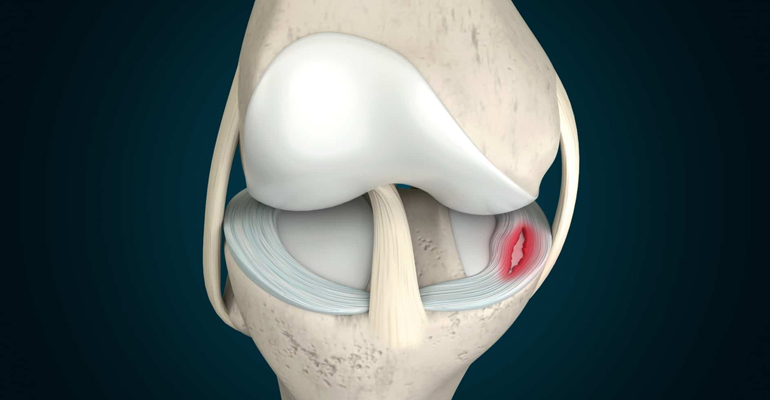-
-
+91-8591556577
-
Meniscus Injury

Meniscus Injury
A meniscus injury is one of the most common knee injuries, often occurring during activities that involve twisting, pivoting, or sudden changes in direction. The meniscus is a C-shaped piece of cartilage in the knee that acts as a cushion between the thighbone (femur) and the shinbone (tibia). It helps absorb shock, distribute weight, and stabilize the knee joint. A torn meniscus can cause pain, swelling, and restricted movement, significantly impacting daily activities and sports performance.
What Causes a Meniscus Injury?
Meniscus injuries typically occur from traumatic events or degenerative changes in the knee joint:
- Traumatic Injury: Sudden twisting or rotating of the knee, especially when the foot is planted, can cause a meniscus tear. This is common in sports like football, basketball, soccer, and tennis, where players frequently change direction or pivot.
- Degenerative Injury: Over time, the meniscus weakens and becomes more prone to tears due to the natural aging process. Degenerative meniscus tears are more common in older adults and often occur from simple movements like getting up from a chair or squatting.
Types of Meniscus Tears
Meniscus tears are categorized based on their location and severity. Some common types include:
- Radial Tear: A vertical tear that occurs in the middle of the meniscus, often from a sudden twist or turn.
- Horizontal Tear: This tear runs parallel to the tibial plateau and can cause the meniscus to split.
- Bucket-Handle Tear: A large tear that causes a portion of the meniscus to flip over, potentially blocking knee movement.
- Flap Tear: A small piece of the meniscus becomes loose and can get caught in the knee joint, leading to pain and restricted movement.
Symptoms of a Meniscus Injury
A meniscus tear may present with various symptoms, depending on the severity of the injury:
- Pain: Pain is often localized to the inside or outside of the knee, depending on the location of the tear. Pain may worsen with twisting or squatting motions.
- Swelling: Swelling around the knee joint typically develops within a few hours of the injury.
- Limited Range of Motion: A torn meniscus can cause stiffness and limit the knee’s ability to fully bend or straighten.
- Locking or Catching: The knee may feel like it’s locking or catching, particularly if a piece of the torn meniscus is blocking joint movement.
- Instability: Some patients experience a feeling of the knee giving way or feeling unstable when walking or standing.
Diagnosing a Meniscus Injury
A physician will conduct a thorough physical examination to assess the knee's range of motion, stability, and tenderness. Specific tests, like the McMurray test, involve rotating the knee to check for clicking or pain that may indicate a torn meniscus.
Imaging tests, such as X-rays or MRI scans, may be ordered to confirm the diagnosis and determine the severity of the tear. An MRI is particularly effective in showing soft tissue injuries like meniscus tears.
Treatment Options for Meniscus Injuries
The treatment approach for a meniscus injury depends on factors like the size, location, and severity of the tear, as well as the patient’s age and activity level. Treatment options range from conservative management to surgical intervention.
Non-Surgical Treatments
For less severe meniscus tears or in cases where surgery is not immediately required, the following non-surgical treatments may be recommended:
- RICE Protocol (Rest, Ice, Compression, Elevation): The RICE method helps reduce pain and swelling. Resting the knee, applying ice packs, using a compression bandage, and elevating the leg can alleviate symptoms in the early stages of injury.
- Physical Therapy: A physical therapy program focused on strengthening the muscles around the knee, improving flexibility, and restoring range of motion can help promote healing and prevent further injury.
- Nonsteroidal Anti-Inflammatory Drugs (NSAIDs): Medications like ibuprofen or naproxen can reduce inflammation and pain associated with a meniscus tear.
- Knee Bracing: Wearing a knee brace can provide additional support and stability, especially during activities that put stress on the knee joint.
Surgical Treatments
If the meniscus tear is large, causing significant symptoms, or not responding to conservative treatments, surgery may be necessary. Surgical options include:
- Meniscectomy: In cases where the tear is located in an area with poor blood supply, the damaged portion of the meniscus may need to be removed (partial meniscectomy). This procedure helps alleviate symptoms and improve knee function.
- Meniscus Repair: For certain types of meniscus tears, particularly those in the outer portion of the meniscus (where blood supply is better), the surgeon may attempt to repair the tear by stitching the tissue back together. This approach is often preferred for younger, more active patients, as it preserves the meniscus and reduces the risk of future knee problems.
- Meniscus Transplant: In rare cases, where a large portion of the meniscus has been removed or damaged, a meniscus transplant may be recommended. This involves replacing the damaged meniscus with donor tissue.
Recovery After Meniscus Injury
The recovery timeline after a meniscus injury depends on the type of treatment:
- Non-Surgical Recovery: With conservative management, recovery may take a few weeks to a few months. Physical therapy is essential in restoring strength and mobility in the knee.
- Surgical Recovery: Recovery after a meniscectomy usually takes about 4-6 weeks. For a meniscus repair, the recovery period is longer, typically 3-6 months, as the tissue needs time to heal. Physical therapy is an integral part of rehabilitation after surgery, helping to restore knee function and prevent stiffness.
